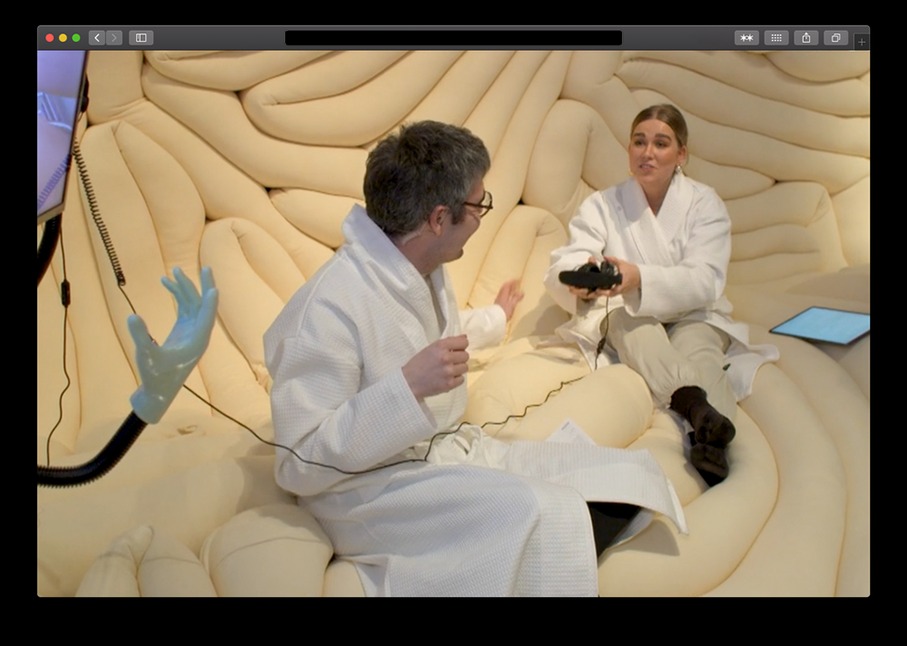
We live in times of a new awareness
WEIRD SENSATION FEELS GOOD, the first museum exhibition dedicated to ASMR, is currently on view at ArkDes in Stockholm
On June 2, 2020 the museum exhibition titled WEIRD SENSATION FEELS GOOD – the first exhibition dedicated to ASMR (Autonomous Sensory Meridian Response) – has opened at ArkDes, the Swedish Centre for Architecture and Design, in Stockholm. The exhibition’s architecture has been designed by the Latvian-based architectural practice ĒTER, and its curator is James Taylor-Foster.
ASMR is a term that describes a physical sensation: euphoria or deep calm, sometimes a tingling in the body. As little as a decade ago, ASMR was largely dismissed as a figment of the imagination. Today the term represents one of the largest movements on the Internet, and it has become impossible to ignore. As academic institutions around the world seek to make sense of the phenomenon, creatives known as ‘ASMRtists’ are building on a cultural movement that transcends language and culture in favour of bodily ‘feels’.
According to the architects’ statement, ‘the exhibition seeks to bring both the body and mind to a state of comfort and higher sensitivity in order for visitors to experience tactile and audio-visual stimuli. The architecture of the exhibition is an attempt to synthesise the creative field of ASMR and its rich material world into a legible spatial language. The most common experience of ASMR is private, perhaps in a bedroom, where a person might feel most calm and protected. Drawing inspiration from traditional spa cultures, flowing water is replaced by streams of contemporary media, aiming to create an atmosphere of safety and privacy in public in which multiple people can be triggered to relax simultaneously. The exhibition’s design offers an acoustically-tempered environment that allows guests to be immersed in a multisensory experience of close-looking, close-listening, and close-feeling.’
It’s worth mentioning that some of the key production processes for the exhibition took place in the Northern Baltics, for example, the hands were 3D printed in Cēsis and silicone-dipped in Sigulda.
The exhibition features a broad collection of ‘Unintentional-’ and ‘Intentional-ASMR’ in a cross-section of global ASMR culture. Alongside contributions by ASMRtists from around the world, the exhibition also features works by motion designers, sound artists, and the renowned television artist Bob Ross.
Due to ArkDes being closed for a while due to COVID-19, the exhibition experienced its first opening in a virtual format on April 7, on the platfom e-flux.com/live. Now that the museum has reopened to the public, the exhibition will be on view through November 1.
Arterritory sat down with the team at ĒTER – Dagnija Smilga, Kārlis Bērziņš and Niklāvs Paegle – to find out more.
Looking back with hindsight, this exhibition project has turned out quite topical considering that shortly before its opening, we were all forcibly pushed into the world of technology and virtual experience – precisely the focus of the exhibition. When working on the exhibition, as an architectural office, did you ever think that the museum/gallery space could realistically transfer to the world of virtual exhibitions and on-line viewing rooms?
Niklāvs Paegle: At the foundation of our studio we explore the presence of public buildings beyond their physical boundaries. Architecture is mostly a very slow and inert process – it always tries to catch up with everything else. In a way, both ASMR as a theme and then the global lockdown gave our team an opportunity to react immediately and adapt the exhibition. Although we missed the act of on-site supervision and had to do all of that from a distance, it was also a very stimulating and dynamic experience. We were constantly switching between the physical and digital perceptions of the viewer while designing. So the digital/analogue structure was in our workflow from the beginning.
Drawing of the scenography for "WEIRD SENSATION FEELS GOOD" at ArkDes by ĒTER (2020) / Copyright: ĒTER / Courtesy: ARKDES
Kārlis Bērziņš: Initially, the exhibition was planned to run for six weeks (April 8 - May 31), however, due to the pandemic and high public interest, it was prolonged to run for seven months (until November 1, 2020). The virtual vernissage was done in the format of a TV broadcast, and the usual exhibition opening was replaced by an emoji-full Livestream chat; as online visitor numbers rose, they were guided through various exhibits – from Bob Ross paintings to artificial skin phone covers.
Before entering the exhibition, you are invited to remove your shoes and put on a robe. Photo:Johan Dehlin / Copyright: Johan Dehlin / Courtesy: ARKDES 
Dagnija Smilga: While working on the architecture for the show, we never imagined that the opening would turn out to be only virtual. Back then we were facing another reality – opening for 3000 visitors; that’s how popular ArkDes exhibitions have become in recent years. For the director, Kieran Long, and the exhibition’s curator, James Taylor-Foster, ArkDes is many things: a vehicle/tool that contains a public space, a research organization, an arena for debate, and a place of experimentation in which to popularize architecture and design for civic society. To maximize the impact, in 2018 they built Boxen – an enclosed gallery within the gallery’s main space. It was designed by Dehlin Brattgård Arkitekter, and is described as a robust machine for fast-changing experimental exhibitions. Boxen has so far hosted quite vivid and contrasting exhibitions, ranging from the provocative nature of Cruising Pavilion – Architecture, Gay Sex and Cruising Culture, and on the other hand, the annual children’s self-made gingerbread house exhibition (this year, as the theme was ‘HOT’, the kids commented on climate change issues through their gingerbread house designs).
The exhibition features works by Wang & Söderström and Marc Teyssier. Photo:Johan Dehlin / Copyright: Johan Dehlin / Courtesy: ARKDES
Now that we’ve lived through all of this, how do you see the future interaction of digital and analogue technologies in museum exhibitions as well as in architecture? Could this develop as a separate niche, or has that already happened?
K.B.: The digital realm had entered everyone's life before the pandemic, however, the pandemic has certainly accelerated our adoption of it. Currently we are experiencing a steep learning curve and we’re being taught the hard lesson of how to be socially connected when we cannot be physically present. Institutions like museums are like community centres: besides exhibitions there are also talks, screenings and performances, all designed to bring people together. I see ways how the digital can help to bring people together physically and emotionally.
The exhibition features works by Andreas Wannerstedt. Photo: Johan Dehlin / Copyright: Johan Dehlin / Courtesy: ARKDES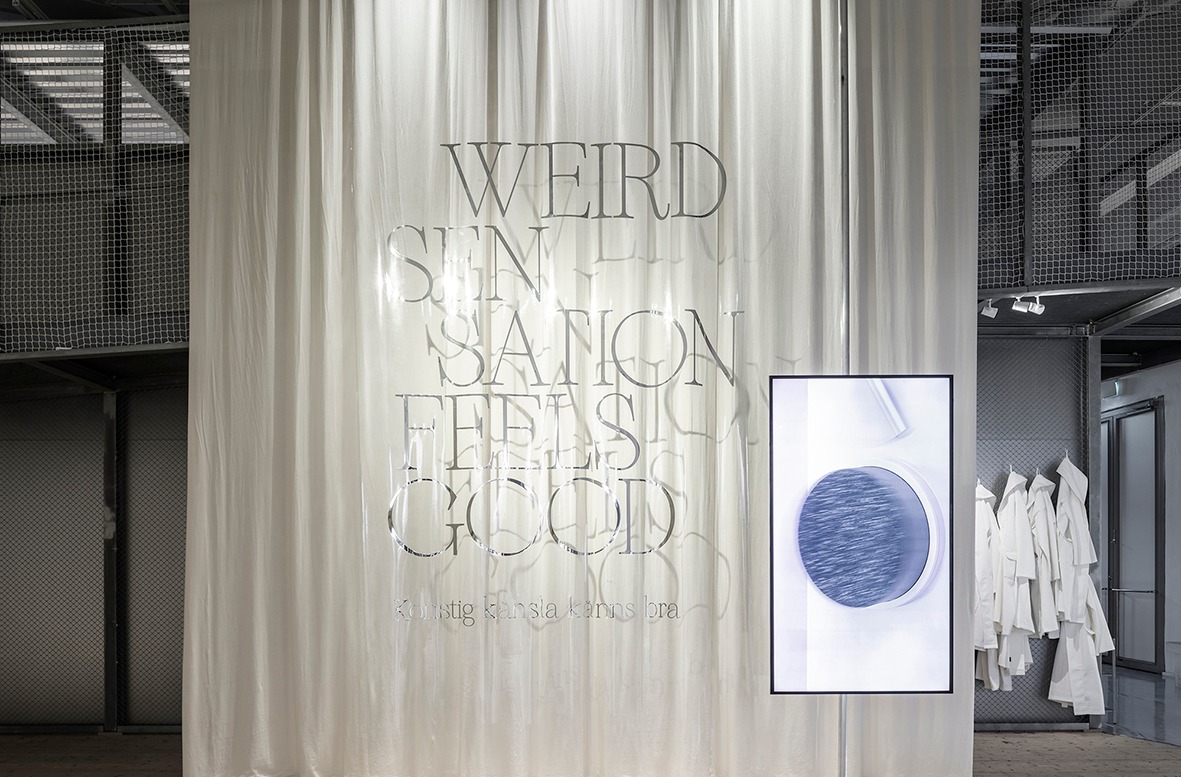
D.S.: Museums and exhibitions have been digital already for some time now. However, this dimension has never been the only one. Now, taking into account the current situation in which the options for physical presence have become fewer, many great video platforms and online communication tools have appeared in our daily routine. We now all know that we have the technical tools, however, it is important to find the right ways to use them to raise quality and creativity. Our studio is always balancing between the use of digital tools and the analogue world of materiality. We are fascinated by the contrasts of both.
Pillow_diagram, "WEIRD SENSATION FEELS GOOD" at ArkDes by ĒTER Architects (2020) / Copyright: ĒTER 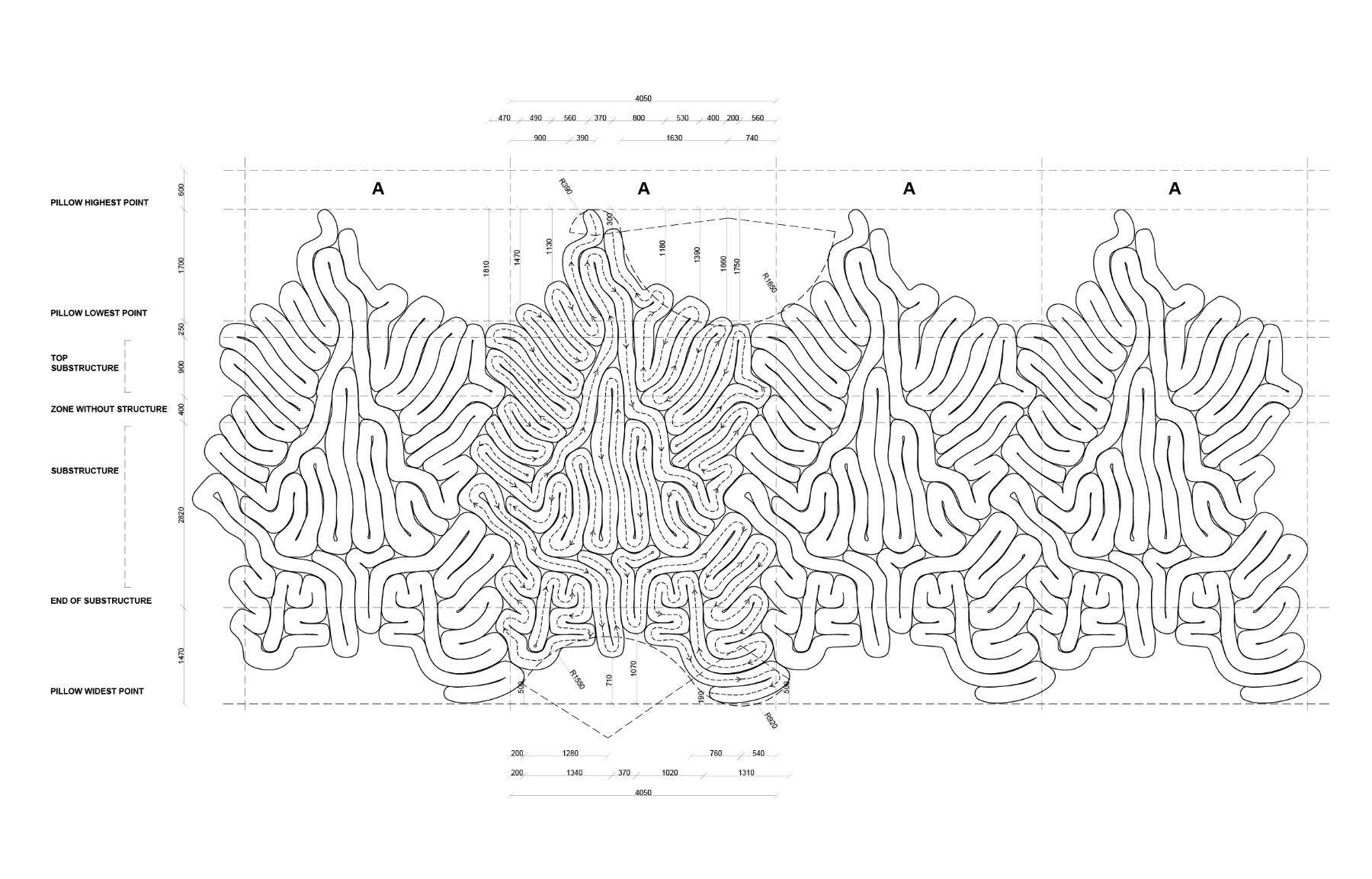
N.P.: I personally do not believe in ‘digital only’. The digital world offers endless possibilities, yet its potential is often misused and becomes meaningless. The greatest challenge in the future is how to bring the digital and physical worlds together – create overlaps and intersections. In the early 19th century, the idea of ‘faux terrain’ was used to visually merge the physical and spatial values of a painting with real, built-up foregrounds. Physical and digital content should serve as enriching extensions of one another instead of being flat copies. For many years, I have been inspired by places like Ars Electronica in Linz, Austria, and Stiftung Sitterwerk in St. Gallen, Switzerland, which is experimenting with dynamic order, connecting a physical collection of materials and publications in innovative digital ways. Curated collections are saved and can be recalled in the digital catalogue, and sensitive tables through RFID chips read user-altered locations of artefacts. Ars Electronica experiments with a special facility, Deep Space, where visitors are able to literally take a walk inside a simultaneous 4-plane projection. Imagine being inside The Last Supper in a super-high resolution that is beyond the capacities of the human eye.
Exhibition plan, "WEIRD SENSATION FEELS GOOD" at ArkDes by ĒTER Architects (2020) / Copyright: ĒTER
ASMR is about focus, unhurriedness, and empathy. Could one say that ASMR is a sign of these times – a peculiar instrument to get us through them while, at the same time, getting closer to ourselves, the latter having undeniably been a problem of our recent (chaotic and ‘loud’) lives?
N.P.: In the 60s, artists and science fiction writers brought to life the concept of cyborgs – proposing the idea that we could grow artificial body parts, thereby amplifying our senses and giving humans superpowers. YouTube-based ASMR content, with the help of smartphones as extensions of our bodies, has reanimated some of these ideas into a real-life scenario. It is striking that we use these new superpowers mainly for pleasure and relaxation. Contrary to its negative preconceptions, technology has proved to be able in bringing people together in a crisis like this one, connecting rather than isolating.
Silicon hand painting process, "WEIRD SENSATION FEELS GOOD" at ArkDes by ĒTER (2020) / Copyright: ĒTER 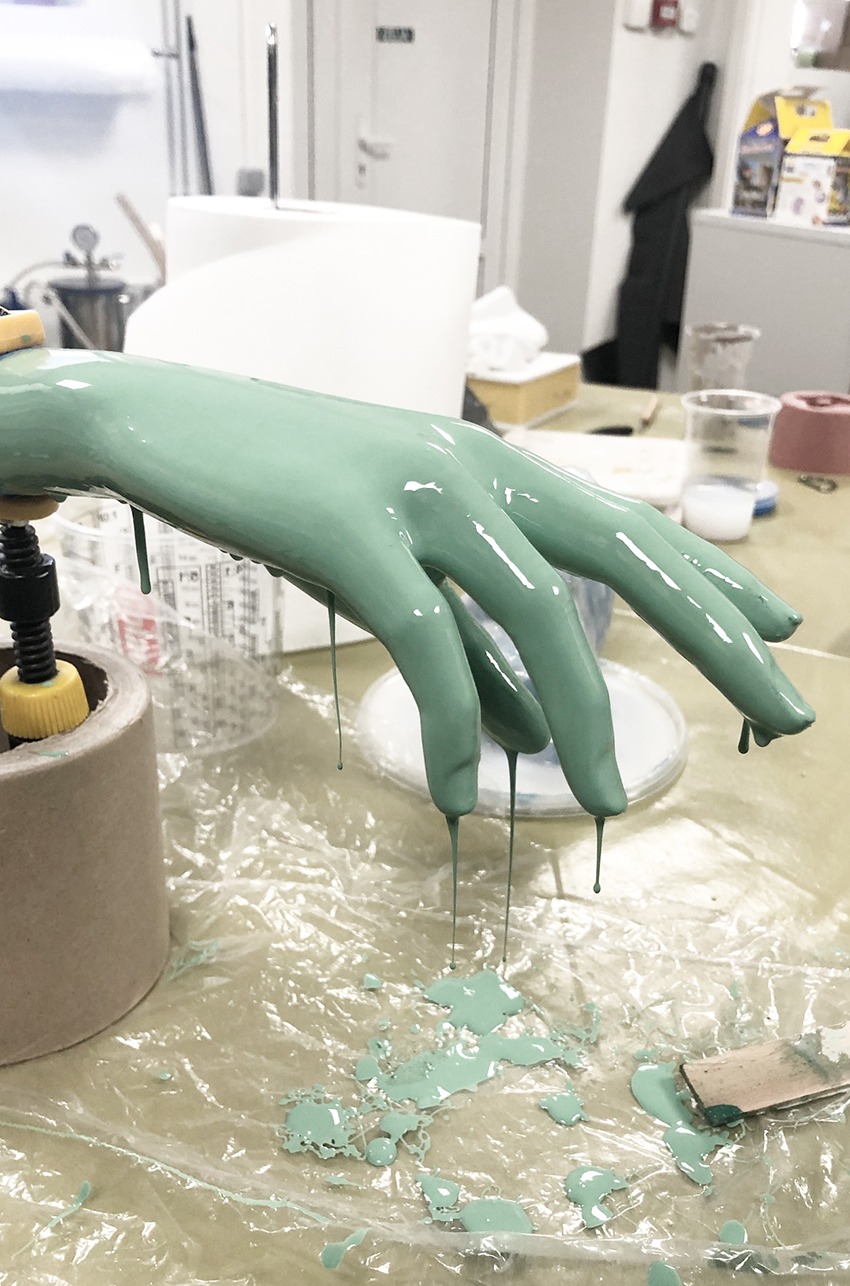
D.S.: In some ways, ASMR is an instrument with which to take in the moment of slowness in this interconnected world in which we are perhaps lonelier than ever before. As the curator, James Taylor-Foster mentioned during the opening discussion that it is loneliness enhanced by the digital, where the screen is the main communicator and ASMR, as a new type of well-being, functions as a bandage. This subculture explains how we live today, but it is most likely not the solution to the problem.
K.B.: People experience ASMR privately in a bedroom atmosphere, where one feels calm and protected. Similar to meditation, ASMR is experienced simultaneously with the body and mind. Through audio-visual triggers in video platforms, ASMR make room for close-looking, close-listening, and close-feeling. This is the first exhibition dedicated to ASMR and also the first time it has been experienced in a space designed for ASMR.
Image still from the Virtual vernissage / Copyright: ARKDES / Courtesy: ARKDES
As architects, what was the greatest challenge that you faced while working on the design of this exhibition? How did the museum decide to ask you to participate?
D.S.: We were invited in autumn of last year, along with four other young architecture practices worldwide, to give a conceptual proposal – an answer to the curator's statement. The main challenge was to design an exhibition (on a very tight budget and within a small time-frame) that not only looks a certain way, but also feels and sounds special. The relationship between technology and the human body takes a material and tactile form. The risk and the experiment we took to achieve the result is a common effort that lies in-between a wonderful collaboration.
K.B.: Taking a risk by sourcing materials and production locally to address a truly global audience allowed us to have custom-crafted objects and achieve higher quality in general. Key production processes took place in the Northern Baltics: the hands were 3D printed in Cēsis and silicone-dipped in Sigulda. The textile for the 1km-long pillow was woven in Pärnu and sewn in Cēsis, later to be stuffed in Stockholm. The walls of Boxen merge with the floor by way of soft-folding biomorphic pillows. These pillows resemble the inner tissue of the body, the folds of the brain, audio cables, and erratic waveforms. Video works are suspended from the ceiling as ‘TV chandeliers’ out of which gentle silicone-dipped hands reach out to serve headphones.
D.S.: For the large pillow we did loads of tests – 1:1 mock-ups of researching the fabric behaviour in terms of stretching, filling, stacking, shrinking. The stuffing, polystyrene beads, will be recycled after the exhibition.
N.P.: ASMR has never existed in a physical public form, yet it has a very strong visual and material language. We were focusing on how not to lose ourselves in the overwhelming amount of data and how to distill it to its essence.
Silicon hand holding headphones. Photo: Johan Dehlin / Copyright: Johan Dehlin / Courtesy: ARKDES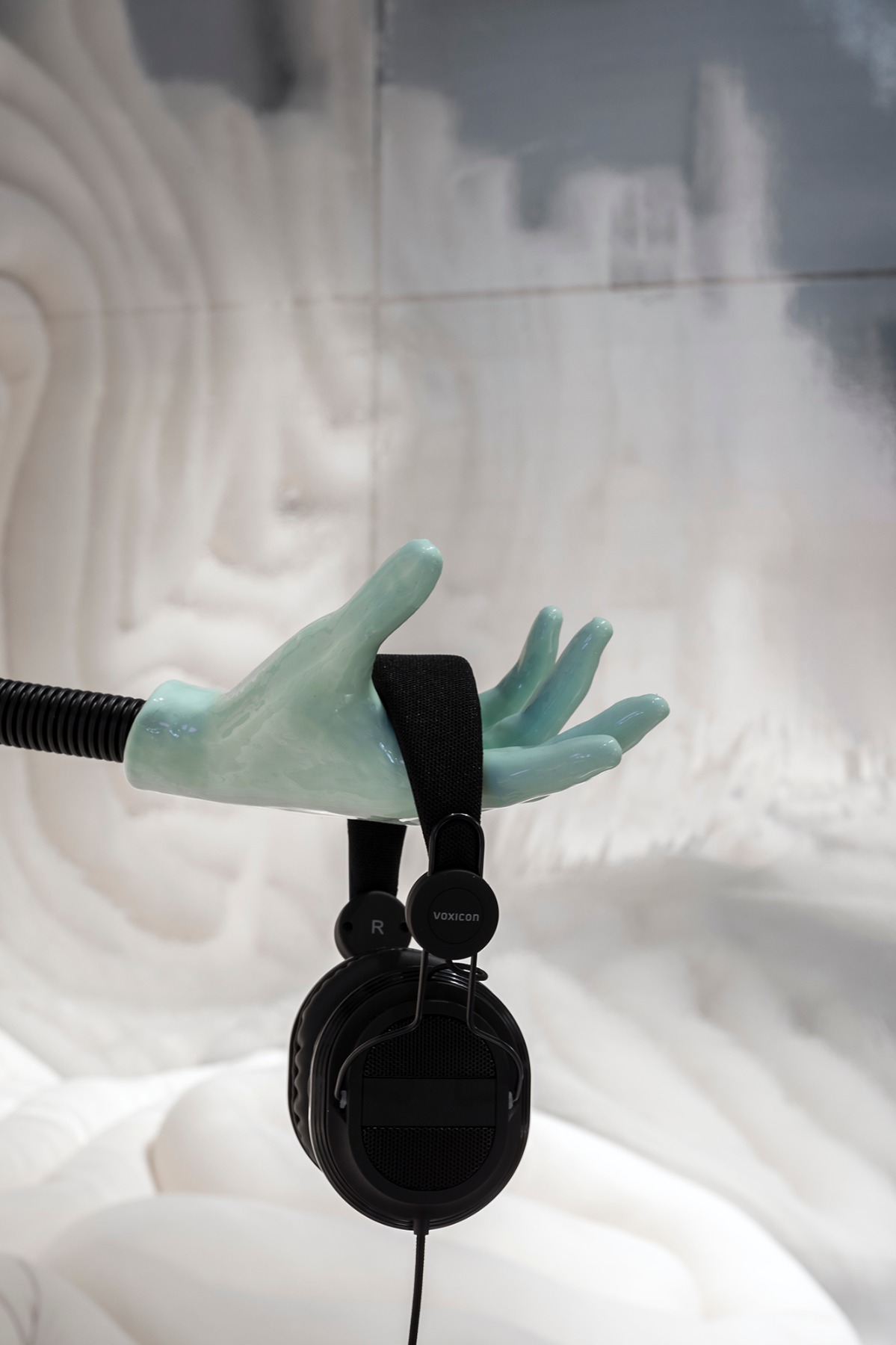
To some extent, ASMR also expands our existing perceptions of the environment, space, and the world we live in, showing that everything is in motion, everything is ‘alive’, and that we humans are not separated from nor are superior to the rest of the players in the biosphere. Do you agree that in this way, through technology, we are also encouraged to think and review our relationships with the rest of the players in our environment?
N.P.: We certainly feel that ASMR has become an ongoing interest and reference in our studio work, allowing us to re-think public buildings and public spaces. When designing, I now often ask myself: ‘How could we make it more ASMR?’ It can be an integral part of an architectural practice – raising awareness of our bodies in relation to material and tactile qualities of the environment. ASMR often goes into extremes with exaggerated, synthetic material operations to make the ‘trigger’ more accessible. Essentially it is about the fascination of simple acts. We live in a time of a new awareness and people are longing for reconnection with nature in a meaningful way; we want to feel something profound together. I think this is precisely where architecture is able to come in – tactile theatres, immersive museums, sensitive libraries – places to share with others.
"TV chandeliers" designed by ĒTER are suspended in the space. Photo: Johan Dehlin
Copyright: Johan Dehlin
Courtesy: ARKDES
D.S.: Watching Bjork explaining a TV, seeing a woman cooking onion rings, or following the bathing ritual of two fluffy puppies places the mind in a slightly different place – outside of this ‘big data world’. After entering the world of ASMR and watching many YouTube videos, things suddenly appear to be in close-up, like looking through a magnifying glass.
Aesthetics and haptic materiality, and high-quality private and public spaces all connected with cross-border connections such as wi-fi, perhaps, are the things that we are looking for now. Recent global existential challenges highlight the value of physical space and local products. Our practice is always within this matter (substance) – ĒTER [as in ‘ether’ – ed.] – in-between nature, technology and contemporary culture, where global values and connections are injected into specific local environments.
Title image: The exhibition features works by Bob Ross. Photo: Johan Dehlin. Copyright: Johan Dehlin. Courtesy: ARKDES
